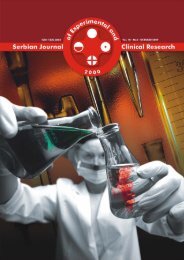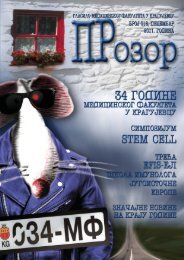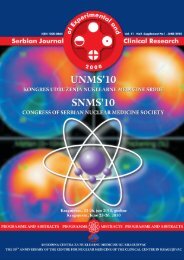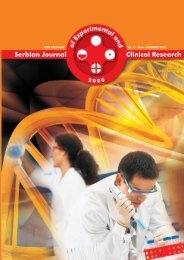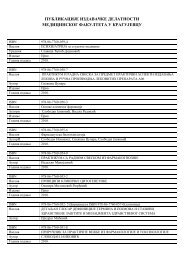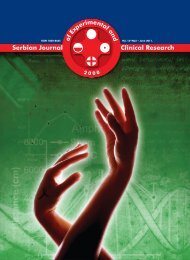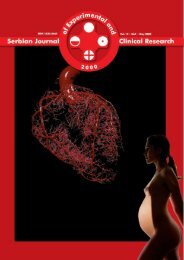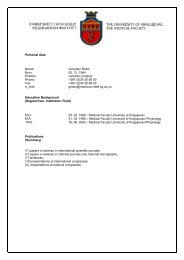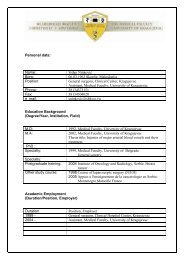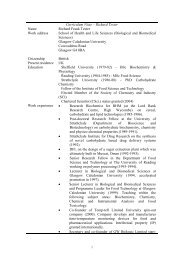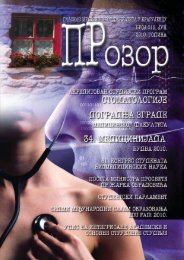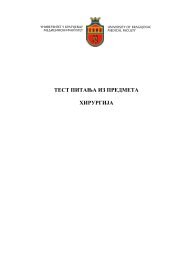ORIGINAL ARTICLE ORIGINALNI NAUČNI RAD ORIGINAL ARTICLE ORIGINALNI NAUČNI RADTHE EFFECT OF SEROTONERGIC LESIONS IN THE MEDIALPREFRONTAL CORTEX ON PSYCHOTOMIMETIC DRUG-INDUCEDLOCOMOTOR HYPERACTIVITY AND PREPULSEINHIBITION IN RATSSnezana Kusljic 1,2 <strong>and</strong> Maarten van den Buuse 2,31Department <strong>of</strong> Nursing, University <strong>of</strong> Melbourne, Carlton, Victoria, Australia2Behavioural Neuroscience Laboratory, Mental Health Research Institute, Parkville, Victoria, Australia3Department <strong>of</strong> Pharmacology, University <strong>of</strong> Melbourne, Carlton, Victoria, AustraliaReceived / Primljen: 18. 01. 2011. Accepted / Prihvaćen: 03. 03. 2011.ABSTRACT:While dysfunction <strong>of</strong> the prefrontal cortex has been repeatedlyimplicated in the pathophysiology <strong>of</strong> schizophrenia,the role <strong>of</strong> serotonin in this brain region in schizophrenia isunclear. We therefore examined the effects <strong>of</strong> local serotonindepletion in the medial prefrontal cortex on psychotomimeticdrug-<strong>induced</strong> locomotor hyperactivity <strong>and</strong> prepulseinhibition, two animal models <strong>of</strong> aspects <strong>of</strong> schizophrenia.Pentobarbital-anaesthetised (60 mg/kg, i.p.) male Sprague-Dawley rats were stereotaxically micro-injected with 0.5μl <strong>of</strong> a 5 μg/μl solution <strong>of</strong> the serotonin neurotoxin 5,7-dihydroxytryptamineinto the medial prefrontal cortex. Twoweeks after the surgery, rats underwent behavioural testing.When compared to sham-operated controls, rats with me-dial prefrontal cortical lesions did not show changes in eitherpsychotomimetic drug-<strong>induced</strong> locomotor hyperactivity orprepulse inhibition. However, following the administration <strong>of</strong>the serotonin neurotoxin into the medial prefrontal cortex,the concentration <strong>of</strong> serotonin was reduced by 60%. These resultssuggest that serotonin depletion in the medial prefrontalcortex does not lead to dysregulation <strong>of</strong> subcortical dopaminergicactivity <strong>and</strong> does not cause aberrant responses toenvironmental stimuli.Keywords: schizophrenia, serotonin, medial prefrontalcortex, prepulse inhibitionRunning title: Serotonin, the medial prefrontal cortex<strong>and</strong> behaviourAbbreviations used:5,7-DHT- 5,7-dihydroxytryptamine5-HT- 5-hydroxytryptamine, serotonin5-HT 1-7, A-F- serotonin receptor subtypesANOVA- analysis <strong>of</strong> varianceD 1-5- dopamine receptors 1-5DRN- dorsal raphe nucleusGABA- γ-aminobutyric acidHPLC- high pressure liquid chromatographyi.p.- intraperitonealMRN: median raphe nucleusmPFC- medial prefrontal cortexNMDA- N-methyl-D-aspartatePPI- prepulse inhibitionPP- prepulse intensityPP8- prepulse <strong>of</strong> 8 dBs.c.- subcutaneousSEM- st<strong>and</strong>ard error <strong>of</strong> the meanVTA- ventral tegmental areaUDK 612.8:577.175.8 ; 616.895.8 / Ser J Exp Clin Res 2011; 12 (1): 11-19Correspondence to: Dr. Snezana Kusljic, Department <strong>of</strong> Nursing, Melbourne School <strong>of</strong> Health Sciences, Level 5, 234 Queensberry Street,Carlton VIC 3010 Melbourne Australia, Tel: +613 8344 9428, Fax: +613 9347 4375 , Email: skusljic@unimelb.edu.au11
INTRODUCTIONSchizophrenia is a chronic <strong>and</strong> severe psychiatric disorderthat generally occurs in late adolescence or earlyadulthood. Approximately 1% <strong>of</strong> the population worldwideis affected by schizophrenia, placing a heavy burdenon society, both in terms <strong>of</strong> emotional suffering <strong>and</strong> economicloss [1]. Schizophrenia is the classic example <strong>of</strong> adisorder that always has psychosis as one <strong>of</strong> its features[2]. As psychotic episodes are extremely debilitating,management <strong>and</strong> treatment aim to reduce <strong>and</strong> eliminatethese dramatic personality changes, consisting <strong>of</strong> irritability,confusion <strong>and</strong> paranoia associated with hallucinations<strong>and</strong> delusions. Antipsychotic drugs are used to treatnearly all forms <strong>of</strong> psychosis, including schizophrenia.It has been generally accepted that the mechanism bywhich antipsychotic drugs decrease hallucinations <strong>and</strong>delusions is mediated at least in part by dopamine D 2receptorblockade [3-5]. Moreover, atypical antipsychoticdrugs, such as olanzapine, display a unique neuropharmacologicalpr<strong>of</strong>ile; they minimise psychoses by interactingwith a number <strong>of</strong> neurotransmitter <strong>and</strong> receptorsystems through binding at multiple receptor sites. Olanzapinehas a high affinity for serotonin 5 HT 2A, dopamine,cholinergic, histamine <strong>and</strong> α1-adrenergic receptors [6].However, the most important <strong>mechanisms</strong> underlyingthe clinical properties <strong>of</strong> atypical antipsychotic drugs appearto be mediated by interactions with the serotonin5-HT 2Areceptor subtype [7, 8].Serotonin is one <strong>of</strong> the major neurotransmitters in thehuman brain <strong>and</strong> plays a central role in the regulation <strong>of</strong>a wide range <strong>of</strong> behaviours, such as mood, eating <strong>and</strong> thestress response [9-11]. The serotonergic projections arisingfrom the brainstem raphe nuclei form the largest <strong>and</strong>most complex efferent system in the human brain [12, 13].The axons <strong>of</strong> dorsal raphe nucleus (DRN) neurons contributeto the majority <strong>of</strong> the serotonergic innervation in thefrontal cortex, ventral hippocampus <strong>and</strong> striatal regions[14, 15], while the axons <strong>of</strong> median raphe nucleus (MRN)serotonergic neurons are more abundant in the dorsal hippocampus<strong>and</strong> the cingulate cortex [16, 17]. The hypothalamus,the substantia nigra <strong>and</strong> the nucleus accumbensreceive serotonergic innervation from both nuclei [18, 19].This organisation <strong>of</strong> the serotonergic neuronal populationsuggests that serotonin is involved in the regulation <strong>of</strong> differentfunctional systems, such as the motor, limbic <strong>and</strong>somatosensory systems [13]. Thus, it is not surprising thatatypical antipsychotic medications target multiple brainserotonin receptor subtypes. As it is very difficult to assessalterations <strong>of</strong> serotonergic transmission in the pathophysiology<strong>of</strong> psychiatric disorders in the living human brain,animal models are needed.Animal models <strong>of</strong> psychiatric disorders, includingschizophrenia, rely on mimicking specific aspects orsymptoms associated with the disease [20-22]. The twomost widely used models are locomotor hyperactivity <strong>induced</strong>by psychotomimetic drugs <strong>and</strong> prepulse inhibition.Psychotomimetic drugs, such as amphetamine <strong>and</strong> phencyclidine,can induce abnormal behaviours in animals <strong>and</strong>mimic certain aspects <strong>of</strong> psychotic disorders in humans[20, 23-25]. Amphetamine, an indirectly acting sympathomimetic,causes increased dopamine release from presynapticterminals [26], <strong>and</strong> hyperlocomotion <strong>induced</strong> byamphetamine is dependent upon intact subcortical dopamineactivity in the nucleus accumbens [27]. In contrast,phencyclidine interferes with multiple neurotransmittersystems [28]. Phencyclidine acts as a non-competitiveantagonist at the ion channel associated with the N-methyl-D-aspartate (NMDA) glutamate receptor <strong>and</strong>also indirectly facilitates dopaminergic <strong>and</strong> serotonergictransmission [29]. Similar <strong>mechanisms</strong> are also activatedin humans by phencyclidine [30]. Prepulse inhibition <strong>of</strong>the acoustic startle response is an operational measure<strong>of</strong> sensorimotor gating that is disrupted in patients withschizophrenia [31, 32] <strong>and</strong> in rats treated with drugs thatfacilitate dopaminergic activity [33-35]. Furthermore,prepulse inhibition is reduced in rats treated systemicallywith serotonin releasers, such as fenfluramine, direct 5HT 1Areceptor agonists [36-38] <strong>and</strong> glutamate receptorantagonists, such as phencyclidine [39]. The prepulseinhibition-acoustic startle reflex model in rats <strong>of</strong>fers aunique opportunity to asses attentional <strong>and</strong> informationprocessing deficits in schizophrenia, as modulation <strong>of</strong> thestartle responses is similar among mammalian species[40]. In animals, usually the whole body startle responseis measured after exposure to acoustic or tactile stimuli,while in humans the eyeblink component <strong>of</strong> the startleresponse is measured [40].There is a growing body <strong>of</strong> evidence that suggests thatthe hippocampus, amygdala <strong>and</strong> prefrontal cortex play animportant role in the pathogenesis <strong>of</strong> schizophrenia. The activity<strong>of</strong> these brain regions may cause changes in subcorticaldopaminergic activity <strong>and</strong> therefore lead to the inappropriateinitiation <strong>of</strong> behavioural responses to external stimuli.We have previously reported that serotonergic projectionsinto the hippocampus <strong>and</strong> amygdala are differentially involvedin the regulation <strong>of</strong> psychotomimetic drug-<strong>induced</strong>locomotor hyperactivity <strong>and</strong> prepulse inhibition [41, 42]. Asserotonergic projections from both raphe nuclei innervatethe prefrontal cortex, in addition to the hippocampus <strong>and</strong>amygdala, the aim <strong>of</strong> the present study was to determinewhether serotonergic lesions <strong>of</strong> the prefrontal cortex causedbehavioural changes similar to those produced by lesions <strong>of</strong>the hippocampus <strong>and</strong>/or amygdala.In humans, dysfunction <strong>of</strong> the prefrontal cortical areas,with which the medial prefrontal cortex <strong>of</strong> the ratis comparable, is related to psychopathology <strong>of</strong> schizophrenia<strong>and</strong> other psychiatric disorders (for a review,see [43]). A wealth <strong>of</strong> evidence from studies in animals<strong>and</strong> humans indicates that the medial prefrontal cortex(mPFC) is a key component <strong>of</strong> the cortico-limbic-striatalcircuits that generate pathological emotional behaviour[44, 45]. The various subdivisions <strong>of</strong> the mPFC appear toserve separate <strong>and</strong> distinct functions. For example, ven-12



